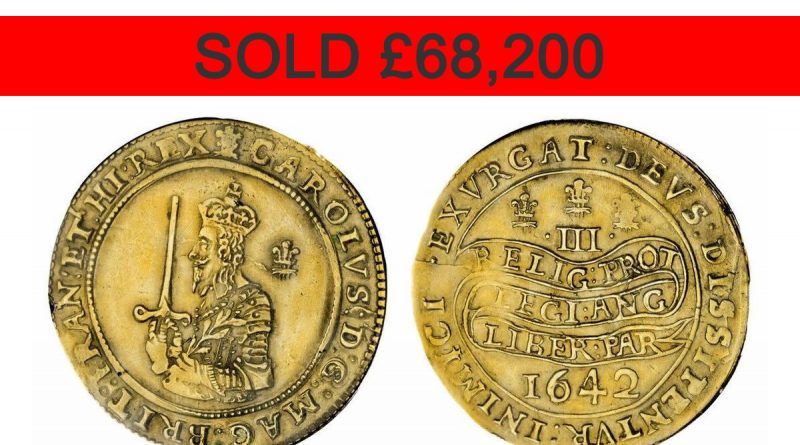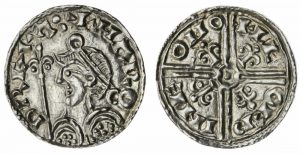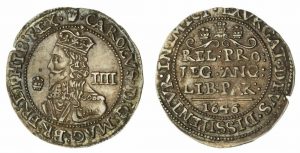Spink Numismatic e-Circular 7 Part I
Spink Numismatic e-Circular 7 Part I
Spink held an auction of British and World coins. The auction catalogue is available here.
Highlighted Lot
Lot 4601, Charles I, Triple Unite

A triple unite, worth 60 shillings, minted in Oxford by Charles I at the start of the Civil War. The historical significance of this coin is in its denomination, legends and mint.
Denomination
At 60 shillings, the triple unite was double the value of any coin previously issued and the most valuable of any hammered coin. This raises the question of why such a high value coin was issued. The most likely reason is that Charles was seeking to impress. He wanted to show that, even though he was cut off from his capital, he could strike a gold handsome gold coin of high value.
Legends on the reverse
The legend around the edge reads EXURGAT DEUS DISSIPENTUR INIMICI, “Let God arise and His enemies be scattered“
Wellington Declaration.
Of more significance is the legend in the centre. This reads RELIG PROT LEG ANG LIBER PAR which is an abbreviated form of RELIGIO PROTESTANTIUM, LEGES ANGLIAE, LIBERTAS PARLIAMENTI. This is the Wellington Declaration made by Charles I on 18 September 1642 when he addressed his troops before the first major pitched battle of the Civil War. He declared to uphold “the Protestant Religion, the Laws of England, and the Liberty of Parliament”. In effect, Charles has placed his political manifesto on a coin.
Oxford
On 29 October 1642, after the battle of Edgehill, Charles established his headquarters in Oxford. He set up a mint at New Inn Hall on 3 January 1643.
In January 1644, Charles formed his own parliament in Oxford, also known as the Mongrel Parliament. He summoned all members of the parliament in London (the Long Parliament). He thus gave visible support to his Wellington Declaration.
Propaganda
The combination of the value and the use of the Wellington Declaration point to this coin being issued as part of Charles’s propaganda campaign.
The king appreciated the power of propaganda. He made use of a press at Oxford University to print pamphlets and the first daily newspaper, Mercurius Aulicus. A pamphlet entitled “A Warning Piece” extolled the virtues of the king’s new coin and attacked the parliamentary coin issues.
The image of the king is also interesting, holding a sword in one hand and an olive branch in the other. In later versions of the coin, the olive branch would become larger.
Dates
An interesting aside is that the coin is dated 1642 when the mint first issued coins in January 1643. Until 1752, England used 25 March, in honour of Lady Day, as the start of the new year. In 1752 the Gregorian calendar was adopted and with the 11 days difference to the Julian calendar, 25 March became 5 April. This is the reason the UK’s tax year ends on that date.
Hence, although the coin is dated 1642, it was issued in what we would now consider to be 1643. It also tells us that it was issued between 3 January, when the mint opened, and 24 March, the end of the year.
Estimate
Estimate: £45,000 – £55,000
Hammer: £55,000
Paid: £68,200, including buyer’s premium and VAT
Selected lots
Below are my picks from the other lots. In addition to the hammer price, there is a Buyer’s Premium of 20% (plus VAT).
All images are © Spink. Click an image to enlarge
Lot 4661, Carausius, Denarius
A detecting find from 2019 in Speen, West Berkshire and recorded at the PAS as FASAM-8CD14C.
The reverse legend and imagery point to a wife of Carausius which has been the subject of numismatic debate since 1752. Dr Sam Moorhead, in his book Coinage of Carausius and Allectus, describes it as “a potentially seismic find”.
It once again demonstrates how much the work of detectorists has served to advance the study of numismatics.
Estimate: £10,000 – £12,000
Hammer: £13,000
Lot 4668, Harold I, Penny
This coin was Lot 29 in the Ennismore collection in September 2020, when it sold for £3,000. That auction was the first one I reviewed when I started this website – Ennismore Collection
Estimate: £2,000 – £3,000
Hammer: £2,600






